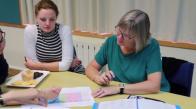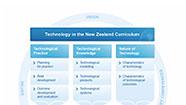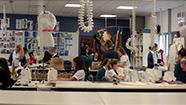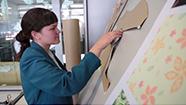Carol Rimmer outlines the programme planning she uses to provide students with broad knowledge.
Programmes to ensure a broad technological literacy
Transcript
Carol Rimmer: If our key aim is for technological literacy, it is important that we as teachers understand the eight components and the three strands and that we embed them into our teaching programmes, along with the subject specific knowledge, and skills that our students need.
We’re given broad curriculum objectives and they are very nicely unpacked for us, so how we plan our programmes at my school (which is a year 9 to 13 secondary school), is that we treat year 9 and 10 as a two-year plan.
Year 9s have four periods a week for the whole year, but it is across the subjects of technology. Year 10, it’s half a year, four periods a week. What we do is, we have generic tasks for all our classes across the subject and generic assessment.
In the senior school we plan for three years, but we all know in the real world, it would be ideal if our students took the subject at year 11, 12, and 13. We all know that that doesn’t happen. They will sometimes take the subject, then drop it for a year, pick it up again, or they come in from other schools with different technological experiences, which makes the planning difficult, but not impossible.
NCEA holds its own problems, or challenges if you like, because we have a huge matrix, and the matrix assesses across all the three strands. As a teacher we have to make our minds up, do we want to assess our students following one component right the way through the three levels, or do we want to scatter across the matrix? At this stage, at our school, we’re inclined to scatter across the matrix doing the teaching of the eight components, but assessing across, in order to give our students the opportunity of assessment and prepare them for scholarship.
When planning our programmes, we like to start with a broad context, because starting with breadth of an idea pulls the students in, especially if we consider their age, their ability, and cultural diversity. We try and find a context that’s going to engage the students, and that’s the first aim. Once we’ve got a context, we can then start planning for the detail that goes in within that context.
If we start with nature of technology and if we look at the social, and historical, and political background to a topic, this gives the students a rich background for their own practice. When they become able, or at the point that they can choose to start to look at fitness for purpose, having that breadth of understanding from the nature of technology strand brings breadth and depth into their own work. I see the technological knowledge strand as being the one that supports practice whether it be systems, modelling, products or all three, ideally, they will support the students in knowing the "how to" and the "why" of what they’re doing.
The whole thing is brought together because they have a firm understanding that they have covered all eight components and can make judgements that are informed.
My challenge to teachers is to choose a broad context, make that the starting point, make sure that you cover all eight components and the three strands (even if it is over more than a year). And give the students experiences in that world of technology so that it also broadens their outlook.
Related videos
School-wide programme planning (04:18)
Cheryl Pym explains how collaboration forms the foundation for school-wide planning in technology education.
Reviewing programme planning in years 7–13 (03:23)
At Diocesan School planning focuses on technology components for years 7–10, and establishing scholarship potential in year 13....
Review of curriculum implementation (03:49)
Margaret van Meeuwen explains how a cycle of self-review has enhanced delivery of curriculum.
A technology department with a digital and design focus (04:13)
Julie Clement shares how a design focus has engaged her students.
Resourcing for a digital and design focus (03:18)
Julie Clement considers how resources influence the authentic experiences for her students.





